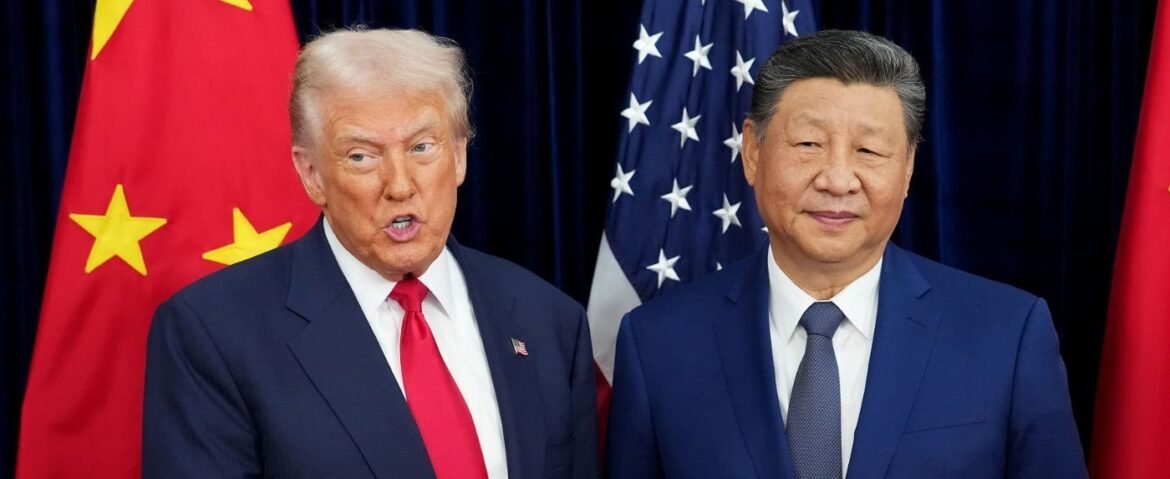The much-anticipated Trump Xi meeting was a milestone in the U.S China relations, with the two leaders taking a moment to shake hands that sparked international concern.
Tapped on the periphery of the Asia-Pacific Economic Cooperation summit at Busan, the meeting was not only the beginning of dialogue but a new beginning in terms of cooperation after several years of tariffs, sanctions, and economic rivalry.
The two countries realized that the rising unease had damaged the industries, supply chains, and investor confidence. Read the news on newstodate.co.uk.
This handshake between heads of state has become a gesture of treading water, as there is a hint that the world’s two biggest economies are finally prepared to relieve the tension in their trade processes and restore confidence in a practical approach to discussions.
What the Trump Xi meeting represented in the international arena
The incident was a sort of landmark diplomatic action, which indicated that Washington and Beijing are ready to leave confrontation behind and seek out areas of agreement.
The Trump Xi session sought to revive sealed communication lines and solve the major disagreements in the areas of tariffs, technology regulation, and rare-earth minerals.
The two parties realized that further confrontation was not only going to undermine bilateral trade but also spill over across global markets.
This was represented in their handshake in the sense that they understood that it was not necessary to compete but to work together, since this was the future key to success.
Background: Trade war, rare-earths, and supply-chain resilience.
The U.S.-China trade war was a burden to the global economies over the years. The U.S. tariffs on Chinese goods and the counter-measures by Beijing, such as the ban on exporting important minerals, left industries in doubt.
US-China Trade Framework Boosts Global Market Confidence
Rare-earth minerals that were a strategic asset in electronics, defense systems, and renewable technologies became a strategic asset. The Trump Xi conference saw the necessity of resilience in supply chains, by pushing towards diversification to limit reliance on a single supplier and encouraging a more even-handed global trading system.
Important subjects were discussed at the negotiations
American tariffs and the possible cut down
President Trump proposed to reconsider and partially lift the obligations on Chinese products in case some economic and environmental requirements must be fulfilled.
This possible change represents an overarching move towards abandoning confrontation and towards a more backbone agreement that focuses on growth, innovation, and market stability.
The strategy of rare-earth and export restrictions in China
The export of certain essential resources to China had caused concern in industrialized countries in regards to bans.
The meeting was characterized by discussions aimed at achieving transparency and mutual understanding in the export of the rare-earth minerals and ensuring that the future policies do not disadvantage commercial or strategic interests, but they should not weaponize the trade dependencies.
Trade in agriculture and soy beans
The dialogue was characterized by agriculture. Rejuvenated Soybean trade between the U.S and China will improve the economy of the rural areas and stabilize commodity prices. It also shows how collaboration within important sectors can act as a transition into broader economic normalization.
Pharma policing and technology surveillance
Other issues that were raised during the meeting were not necessarily on trade. The control of TikTok became a problem of the digital age, and each of the two countries looked at equitable regulations regarding app safety and data control.
The other hot spot was to regulate fentanyl precursors since both parties committed to tightening control on the materials employed to make synthetic opioids, an increasing global problem that needs bilateral collaboration.
Setting and diplomatic situation: Busan, South Korea conference
The Busan meeting gave a neutral platform to this historic meeting. The background of the city highlighted the role of the Asia-Pacific region as the heart of global economic activity.
The U.S. delegation’s Asia tour also underscored the American desire to restore regional relationships and to solve the trade imbalances by diplomacy and not isolation.
Shaking of hands between heads of state
The time the two leaders shook hands became a lasting portrayal of the symbol of diplomacy. This would be a deliberate gesture between two heads of nations to decrease aggression and promote negotiations. It was a personal as well as political gesture, recognizing historic struggles, yet stating the willingness to start anew.
Possible implications and importance of the accord.
Roadmap to a rejuvenated trade relationship.
In spite of the fact that no formal treaty was signed, the Trump Xi meeting resulted in an apparent framework of the U.S.-China trade negotiations. The framework aims to facilitate tariffs, reestablish pathways of industrial communications, and investigate shared lines of clean energy, semiconductors, and supply logistics.
Broader APEC implications
At a summit held in the Asia-Pacific Economic Cooperation, it was highlighted that there was a need to have collective stability in the regional markets.
The U.S.-China summit provided the framework to work together with the idea that the member states should adhere to the principles of free trade, enhance connectivity, and sustainable development of industrial activities.
Difficulties in the future, trade tensions.
Risk of setbacks and tariff warnings.
Nonetheless, even with the optimistic atmosphere, the two countries are not that optimistic. The U.S administration has issued U.S. tariff threats in case China does not abide by the standard of transparency.
On the same note, Beijing is still taking countermeasures in case of any new restrictions. These positions underscore that real reconciliation will be based on follow-through.
The negotiating capability of China.
As a negotiator, China went to the summit as an impressive powerhouse that was assertive and flexible at the same time. The long-term vision of Beijing is based on becoming self-reliant without losing its influence in the whole world.
The tone with which it was measured at the meeting was that of coexistence instead of confrontation.
International situation: wars and elections are influencing the negotiations.
The event took place during a number of urgent concerns in the world. Ukraine, Russia, Israel Gaza updates that were still taking place have changed the priorities in diplomacy, and domestic events like the India Bihar assembly elections have shifted the focus back to political stability.
These changes give further shades of complexity to an already complex international relations network.
Global supply-chain implications and implications for the markets of rare-earth.
The negotiations brought back attention to China’s supply-chain rare-earth and how they are used in the production of goods and services, defense, and green technologies. They both settled on the fact that it is crucial to have stable access to these resources for the world economy.
The resilience of supply chains was also the focus of the discussions, which encouraged diversification and sustainable mining to lessen geopolitical risk.
The target industries are agriculture, technology, and services.
The agenda was beyond the raw materials, and it involved many sectors. The extension of the soybean trade will help American farmers, and technology regulation, especially in TikTok regulation, will redefine the digital transparency standards.
In the meantime, the intentions of the control over fentanyl precursors demonstrate the steps towards the advancement of shared humanitarian interests.
Foreign policy and domestic performance.
The South Korea-Busan conversation demonstrated the readiness to change the tone of the U.S.China diplomacy. The two countries acknowledged the need to enhance regional collaboration under the APEC, but acknowledged the sovereign interests.
As it was observed, this new interest can help the world to avoid falling further into a U.S.-China trade war and instead bring economic stability in the long term.
Prospects of the U.S. China relations.
It is still unknown what is in store, but the symbolic handshake and the peaceful talk indicate that there is a route to follow based on other things, like practical co-operation. An agreement between the U.S. and China in terms of trade is still far away, yet the atmosphere of dialogue now dominates over the confrontation.
The agreement that would arise out of this summit has the potential of transforming the way in which the two countries would deal with technology standards, agricultural exports, and environmental policies in the years to come.
Economic spillovers in Asia and other parts of the world.
The APEC summit U.S.-China face also gave hope to smaller economies that rely on cross-border trade, as they are now very confident. By opening the tariff barriers, exports would increase, infrastructure would be enhanced, and world investment would be revived.
In the meantime, the China export bans discussion remains affecting the ways that countries diversify suppliers and become innovative in the rare-earth industry.
The politics of leadership and diplomacy.
The Trump-Xi meeting was a reminder to the world that, despite the intricacies involved, diplomacy is the most important tool in solving the current-day economic conflicts.
Both leaders struck a balance between being assertive and being pragmatic, and they made it seem that they were willing to find solutions. Their communication supported the idea that a handshake may sometimes have more diplomatic value than months of negotiations.
Conclusion
The Trump Xi gathering is a historical event in the sphere of world relations. The handshake was an indication not only of a personal respect but also of a fresh beginning in a dialogue that was geared towards alleviating the strain between the two economies.
Tariffs, rare earths, and supply-chain resilience were all covered by the two countries as they realized the necessity of collaboration in order to continue the global growth. The Busan talks reiterated the strategic position of Asia in relation to linking economies and facilitating stability.
There is still work to be done, including tariff wrangles and technology regulation, but the encounter added a hesitant hope in an ailing relationship.
With words turned into deeds, the world would start seeing some kind of a reversion to familiar trade ways and a more level-headed international system, under the influence of pragmatic diplomacy and shared economic interests.
FAQs
What was the purpose of the Trump Xi meeting?
This was mainly to lessen trade tensions and ease tariffs, as well as reopen communication between Washington and Beijing to stabilize world markets.
So what was so important about the handshake?
The sign of the handshake between the two leaders was a symbolic change of direction towards co-operation, which meant that they were willing to resume the diplomatic and economic relations.
What role did rare-earth minerals play?
The two parties discussed the dominance of China in the critical minerals and discussed the open systems of fair trade and sustainable sourcing.
What were the other topics that were discussed?
In addition to the trade, leaders also talked about the regulation of TikTok, the control of fentanyl precursors, and how to make the supply chain resilient.
What impact might this meeting have on global trade?
In case the structure results in actual developments, it may be helpful in relieving tariffs, increasing investor confidence, and consolidating the principles of the worldwide economy.


